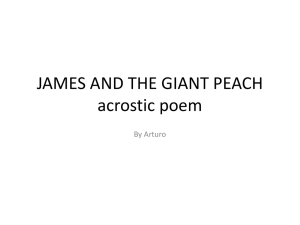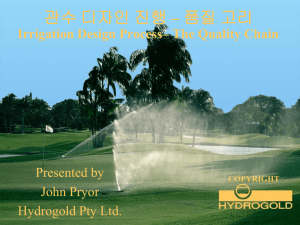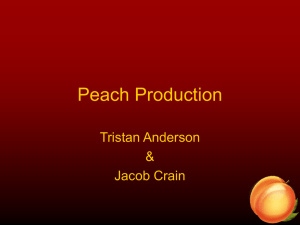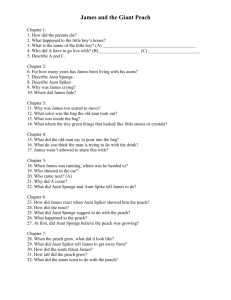Effect of Regulating Water Deficit
advertisement
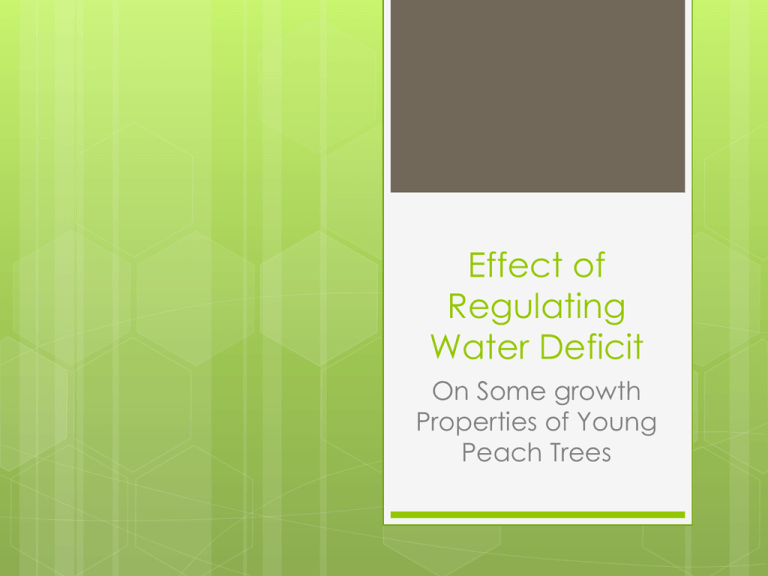
Effect of Regulating Water Deficit On Some growth Properties of Young Peach Trees Team Members Zeinab, H. Behairy Department of Horticulture, Faculty of Agriculture, Ain Shams University, Cairo, Egypt. z_behairy@yahoo.com Mahmoud, M. Hegazi Department of Agriculture Engineering, Faculty of Agriculture, Ain Shams University, Cairo, Egypt Ahmed, El-Gazzar Department of Horticulture, Faculty of Agriculture, Ain Shams University, Cairo, Egypt. Noha, A. Hassan Department of Horticulture, Faculty of Agriculture, Ain Shams University, Cairo, Egypt. Mohamed, A. Shehata Ministry of Water Resources and Irrigation, Cairo, Egypt. Why Water Saving? • Egypt is one of the countries facing great challenges due to its limited water resources represented mainly by its fixed share of the Nile Water and its aridity as a general characteristic. • Egypt is the only country in the world that depends on irrigation 100% Why water saving? Con’t Current Water Resources in Egypt (Millar m3) Nile Water 55.5 Drainage Reuse 5.5 Ground Water 7.5 Treated Sewage 0.7 Rain Harvesting 1.0 -------------------------------Total 70.2 Current Water Requirements in Egypt (Millar m3) Irrigated Agriculture 59.0 Industrial 7.6 Municipal 6.5 Nile Transfer 0.3 Evaporation Network 2.2 ------------------------------------Total 75.6 Future Water Requirements in Egypt (Millar m3) (2017) Irrigated Agriculture 65.1 Industrial 10.5 Municipal 7.5 Nile Transfer 0.4 Evaporation Network 2.1 ------------------------------------Total 85.6 Why water saving? Con’t • • The per capita share of water is less than 900 m3/year which is considered "the water poverty limit” The value may even decrease to 500 m3/capita is the year 2025 due to the growth population So the formulated policy focuses on: Developing new water resources Harvesting rainfall and desalination Improving water use efficiencies About Peach Peach trees, officially known as “Prunus Persica”, got their start in China before spreading in another parts of the World A variety of Fruit trees are native to China tend to require a lot of sun. They also tolerate partial shade but usually would not produce as much as fruit. They prefer soil that is rich and moist but not saturated with water . Peach Origin The peach originated in China and has been cultivated at least 1000 years B.C It has special significance in Chinese culture: the peach tree is considered to be the tree of life, and peaches are symbols of immortality and unity Peach blossoms are carried by Chinese brides. True wild peaches are only found in China, the wild fruit is small, sour and very fuzzy. Global Peach Production Globally, China is by far the largest producer of peaches and Nectarines accounting for approximately 50% of the World production, followed by Italy (10%), Spain (7%), USA (6%), Greece (6%) and France (3%) (FAO 2009). Total production 1.3 Million Tons produced from 3.5 Million acres Peach in Egypt Peaches, Pears, Almonds and Cherries were not introduced to Egypt until the Roman Period (117 – 138 AD) Peach is considered one of the most important fruit crop in Egypt with 79,199 Fed. [Feddan = 4200 m2] dedicated to its cultivation produced 425000 Tons (2009) What is the problem? Traditionally, peach cultivation used to be dominant in Egypt's rainfed areas 80% of the peach cultivation is rainfed while the rest is irrigated farms Despite of the high productivity characterizing the irrigated lands, limited water availability is well known Aim of the study This induces the development of studies focusing on the optimization and efficiency of irrigation water. One of the options proposed for that purpose is the use of regulated deficit irrigation (RDI) (Behboudian and Mills, 1997). Materials & Methods The trial was conducted at the Experimental Farm, Faculty of Agriculture-Ain Shams University, Egypt. Peach trees were two and three years old, growing in loamy soil, with a field capacity 36,25%and welting point 19.50% under drip irrigation system. The source of irrigation is the River Nile with EC 0.3 ds/m. Trees were spaced 2.00 x 1.25 apart, high density farm, and trained to “Y” shape system The experiment included 5 irrigation treatments Table 1. The treatment multiplication (F) factors for the different irrigation treatments. Stages Treatments T1 T2 T3 * T4 T5 Initial stage 1/2-31/3 0.25 0.35 0.45 0.55 0.65 Mid stage 1/4-31/7 (F) factors 0.70 0.80 0.90 1.00 1.10 * Control treatment (F) factors according to Allen et al (1998). Final stage 1/8-30/9 0.45 0.55 0.65 0.75 0.85 For calculating the daily irrigation amount for each treatment for the two growing seasons the following formula recommended by Awady et al (1975) was used Q = H A R F............ (1) Where: Q = Irrigation amount, l / plant / day. H = Reference evapotranspiration (ET0), mm /day. A = Land area, m2/ plant. R = Canopy ratio = plant shadow area at noon, m2 plant area, m2 F = The treatment multiplication factor for different irrigation treatments. Different estimations and measurements: Reference evapotranspiration “Eto” (mm) Water use “WU” (mm) Crop coefficient “Kc” Irrigation water saving % Some growth parameters Experimental design and statistical analysis The complete randomized block design was used with four replicates. Each replicate was represented by one tree. Statistical analysis was carried out using SAS Computer Program (1998) Duncan's multiple range tests was used for comparison between means. Results 2003 2004 8.00 ETo(mm) 7.00 6.00 5.00 4.00 3.00 Se p. Au g. Ju ly Ju ne M ay Ap ri . M ar . Fe b. 2.00 Months Fig. 1. Reference evapotranspirations (ETo) during 2003 and 2004 seasons. Water use “WU” Table 2. Water use “WU” (mm/stage) of young peach trees during 2003 and 2004 seasons. 2003 Seasons Stages 2004 Initial stage Mid stage Final stage T1 14.81 327.11 142.87 484.79 T2 26.70 436.71 213.58 T3 * 42.20 525.73 T4 55.56 T5 66.57 Initial stage Mid stage Final stage Total 18.97 523.73 177.78 720.48 676.99 39.83 709.96 219.75 969.54 252.41 820.34 56.27 792.59 253.26 1102.12 621.23 254.78 931.57 77.59 804.04 299.66 1181.29 673.53 296.74 1036.84 80.69 983.56 339.62 1403.87 Total Treatment * Control treatment (F) factors according to Allen et al (1998). Crop Coefficient "Kc" coefficient Crop Recommended "Kc" values 2003 2004 1.1 1 0.9 0.8 0.7 0.6 0.5 0.4 0.3 0.2 0.1 0 Initial stage Mid stage Final stage Grow th stages Fig. "Kc" of of young peach trees during 2003 and 2004 seasons. Fig.3.2.Crop Cropcoefficient Coefficient “Kc” young peach trees during 2003 and 2004 seasons. Fig. 3. Water use percentage for the different growth stages of young peach trees during 2003 and 2004 seasons. Irrigation water Saving The initial stage that took place during the first two months (February and March) consumed the lowest irrigation water percentage (5.16% and 5.55%) for each growing season respectively. This stage could be considered a phenological stage tolerant to water deficit (non critical period) and RDI can save irrigation water during this stage. On the other hand, comparing these results with what has been done in the private farms without controlling irrigation. Water saving could reach to about 20%. Growth measurements T2 T3 T4 T5 2003 2004 350.00 300.00 250.00 200.00 150.00 100.00 50.00 Fi na l M id In i ti al Fi na l M id 0.00 In i ti al increase Net Shoot extensionrate (cm)(cm) T1 Grow th stages Fig. 4. Effect of different irrigation treatments on the net increase rate of shoot extension of young peach trees during 2003 and 2004 seasons. Table 3. Effect of different irrigation treatments on leaf area (cm2) of young peach trees during 2003 and 2004 seasons 2003 Seasons Stages 2004 Initial stage 31/1-31/3 Mid stage 31/3- 31/7 Final stage 31/7-30/9 Initial stage 31/1-31/3 Mid stage 31/3- 31/7 Final stage 31/7-30/9 T1 30.61bc 38.75b 31.94ab 32.79bc 39.04b 29.89bc T2 35.32ab 38.87b 33.90a 36.59b 40.42b 31.29ab T3 * 37.46a 47.78a 35.22a 40.92a 48.58a 35.90a T4 36.59a 47.79a 30.06ab 40.51a 48.70a 32.71ab T5 27.74c 38.21b 26.26b 28.96c 39.91b 26.17c Treatment Means having the same letter (s) in a column are not significantly different at a level 5%. * Control treatment (F) factors according to Allen et al (1998). Recommendations It is recommended to use the crop coefficient “Kc” 0.28 for scheduling the irrigation program for the initial stage, “Kc” 0.88 for the Mid stage and “Kc” 0.65 for the final stage to obtain vigorous growth and efficient water saving under the same circumstances. Farmers should be advised to follow the indicative cropping pattern Recommendations Con’t Increasing water association supervisors who will facilitate and coordinate between farmers to insure that they work as one team. Research as a dynamic process, is considered the key action of the policies success.
